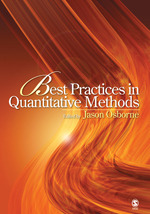Best Practices in Quantitative Methods
- Jason W. Osborne - Clemson University, USA
Data Collection & Analysis | Educational Evaluation | Quantitative/Statistical Research (General)
Basics of Best Practices, in which a comprehensive review of basic statistic and methodological practices is covered, including core statistical methods and critical data analysis issues such as power, effect sizes, and assumptions;
Advanced Best Practices, leading with logistic regression, and moving through IRT, Rasch Measurement, HLM, Meta-Analysis, and the inimitable area of Sampling; and
The Implications of Best Practices, including a discussion of the ethical implications of quantitative analysis.
Each chapter contains a current and expansive review of the literature, a case for best practices in terms of method, outcomes, inferences, etc., and broad-rangning examples along with any empirical evidence to show why certain techniques are better. The book encourages best practices in three very distinct ways: 1) Some chapters will describe important implicit knowledge to readers. For example, one of the most common data transformations is the square root transformation. Statistics and quantitative methods are filled with examples of these seemingly mundane aspects of research life that makes a substantial difference. Chapters in this book gather the important details, make them accessible to readers, and demonstrate why it is important to pay attention to these details. 2) Other chapters compare and contrast analytic techniques to give readers information they need to decide the best way to analyze particular data. For example, exploratory factor analysis has up to eight extraction methods, several rotation options, multiple ways to decide how many factors you have, and it is often the case that the options are not clearly described or discussed. Some of the chapters will examine instances where there are multiple options for doing things, and make recommendations as to what the ôbestö choice (or choices, as what is best often depends on the circumstances) are. 3) Finally, there are always new procedures being developed and disseminated. Many times (not all) newer procedures represent improvements over old procedures. Some chapters will present and explain new options for data analysis, discussing the advantages and disadvantages of the new procedures in depth, describing how to perform them, and demonstrating their use.This book is an invaluable resource for graduate students and researchers who want a comprehensive, authoritative resource to go to for practical and sound advice from leading experts in quantitative methods.





